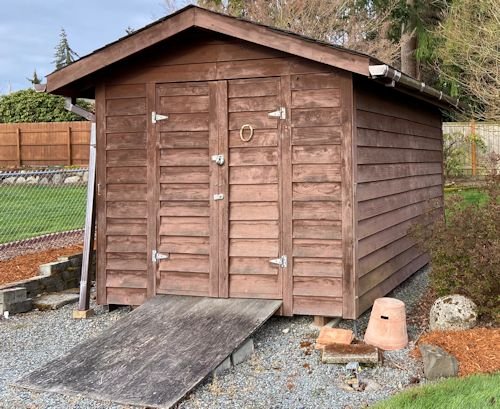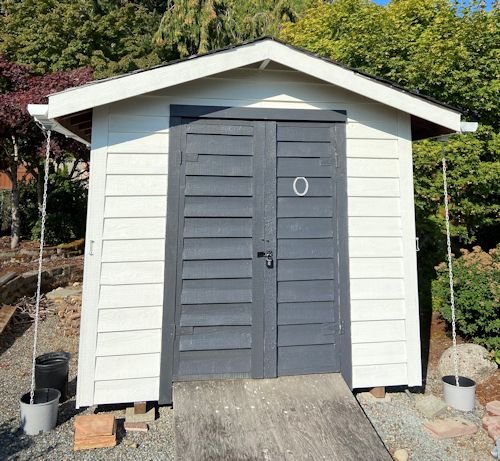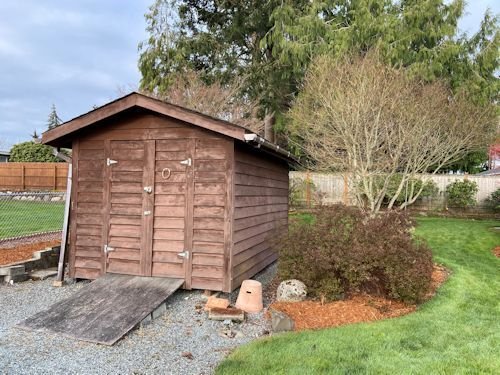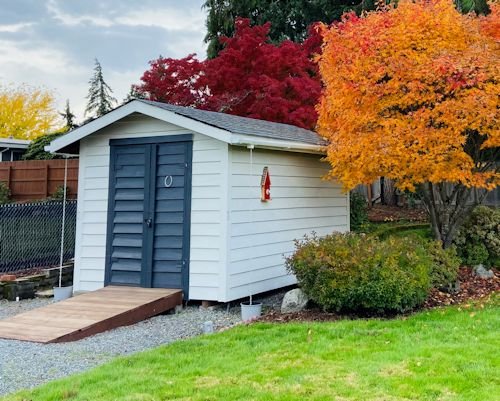Shed Ramp With Decking Top
Step 2 Shed Makeover: build a ramp
Save that old shed!
project by Kevin Sherrod
Disclosure: This site contains affiliate links. As an Amazon Associate, I earn from qualifying purchases. Clicking on links, and purchasing products, may result in the seller paying us compensation at no extra cost to you. Affiliate links are in green.
Also see:
lifestyle blog
Shed Makeover Step 1: Repair & Paint Shed
Deck Projects
I love love love our new shed
Step Two: Build A Shed Ramp
The first step in our shed make-over was to spruce up the shed itself. To see that project, go to: Step 1: Repair & Paint Shed. That consisted of replacing some siding, cleaning and painting the exterior, and adding new chain downspouts.
The second step was to build a new ramp. The old ramp a somewhat flimsy piece of plywood, lying over some boards and pavers. It was safe (barely), but the board was starting to rot, plus the overall piece was unsightly. A new ramp was definitely needed.
TOOLS
Good quality painter's mask (old carpets are dirty and full of dust)
T bevel angle finder , pencil, combination square
Sandpaper - if needed
Paint brushes - sizes of your choice
circular saw
angle finder
#10 1 5/8” deck screws (for deck boards); 3” deck screws (for frame)
boards: 2” x 6” pre-treated boards (for frame)
1” x 6” deck boards (dry thoroughly, clean with deck cleaner, dry)
exterior paint or stain, plus wood cleaner, paint brush or roller for applying stain or paint
deck stain (or paint - we cleaned and stained our reclaimed boards)
gravel (or pavers) - the wood ramp frame is made from pre-treated wood, but should not be placed directly on soil.
STEPS to building a ramp
There are three steps to building a ramp.
Step one is to build the frame.
Step two is to attach frame to the shed.
Step three is to add the decking to the top of the frame.
Compute Ramp Size
The frame is basically just a rectangular box. However, there must be a slope to the ramp, so adjustments must be made. The general rule is there is a 2” rise for every 12” run. In other words, the run (length of ramp) is 6 x the rise. That provides a nice, gentle slope. The rise is the distance from the ground at the shed threshold the deck will come to. Start with that number. How high is your ramp off the ground at its starting point at your shed door? From there, you can compute how long the ramp needs to be (the run).
Let’s say your rise is 12” (your ramp is one foot off the ground at the door). Your run (length of ramp) would need to be 6 feet. Your ramp them would be 6 feet long.
Width of ramp is a personal preference. We made ours to be approximately the width of the door.
The photos below show the original shed and ramp, before our shed makeover, and the shed ready for the new ramp.
Exterior Electrical Outlet
The shed had an electrical outlet near the ramp that frequently shorted out in wet weather. We had a professional electrician install a proper box and cover.
STEP 1: Build The Frame
READ THROUGH ALL INSTRUCTIONS BEFORE BEGINNING THIS PROJECT.
Use the framing boards (2” x 6”) to create the frame.
As stated above, the ramp is basically just a rectangular box (frame), with decking over the top. The frame, with decking top, is the ramp. The ramp is then attached to the shed.
The twist is that the frame must be angled on each end to allow for the slope of the ramp. Unlike a deck, the ramp is not flat on the ground. It will slope from the outer end up to the shed door opening.
The drawing below shows a side frame board (in red), and the lower part of the shed (shown in gray). As you can see, you cannot simply build a straight frame and attach it. Angles must be cut to account for the slope. The ramp in the drawing has a gap against the front of the shed, and is not lying flat against the ground on the far end.
Cut Angles
Cut the boards to the length needed for your slope (in the example above the boards would be cut to 6 feet long). Place the board up against the shed, as shown in the drawing above. Mark the board for the far end angle cut (A).
We wanted the frame board to be 2” at the end, drew a line so that the cut would leave a 2” width. Mark your board for cutting. Use a square to draw a straight line for the “A” cut.
Once that cut is made, place the board against the shed. Use the T-bevel angle finder to determine the angle for the “B” cut.
NOTE: our ramp was not actually this high on the shed. I am merely showing the angle cuts in the diagrams below. The drawings are not to scale.
Cut correctly, the frame boards will lie nicely on the ground at “A” end, and will lie against the shed at “B” end.
Cut All Frame Boards
Once we were happy with our board, we used it as a template to cut 3 more boards. We had a total of 4 boards.
Attach End Board To Angle End Of Frame Boards
Turn the four boards over (so angle side is up). Attach a board across the end of the angle boards - on the angle side of the boards. We placed our end board so that the frame boards were 16” apart on center. Use the framing screws (longer screws) to attach the end board to the angle boards.
We attached so that the side edge of the end board was flush with the angle boards’ ends.
Turn the unit back - right side up. The photo below shows the board attached, and the unit is right side up.
The following photo shows the end piece attached to all four boards. The gravel will be pushed back in around the boards.
Attach Headboard
To finish the frame, attach a headboard to the end of the shed end of the frame. Use the framing screws (longer screws). This connects the four angle boards on the shed end.
NOTE: the connecting board lies flat on the ground on the angle end, but is attached vertically to the boards on the shed end, so it will lie flat against the shed threshold.
The connecting boards are shown in black in the drawing below.
NOTE: The ramp IS NOT CONNECTED to the shed at this time. The diagram is merely to show how the frame end boards are attached to the four angle boards.
STEP 2: Attach Frame To Shed
As stated above, my diagrams are not to scale, and the ramp was not actually very far off the ground at the shed end.
We placed pavers under the frame on the shed end, as extra support.
Place the frame against the shed threshold to check for door clearance. Place the FIRST deck board (board closest to shed) on the frame. Check for door clearance.
Once you are sure your door clearance is correct, you can attach the frame to the shed threshold. Screw the frame to the shed by attaching the frame board at the shed end to the shed threshold. Use framing screws.
The following photo shows the ramp in place, ready for the first deck board.
Step 3: Prepare Deck Boards - clean and stain
If not already done, stain the frame before adding the deck boards.
Measure & Cut Deck Boards
Decide whether you want an overhang on each side of your frame. We chose to have the deck boards come up flush with the sides of the frame (no overhang).
All boards were cleaned, cut and stained EXCEPT the first board. It was installed (see Step 4) and then the frame and first board were stained.
Clean Reclaimed Wood Deck Boards
We used reclaimed wood decking from a friend’s deck. He had replaced the deck with patio pavers.
The boards were in good shape; they just needed a good cleaning, and needed new stain and sealer.
Follow instructions on wood deck cleaner, if you are using reclaimed wood. We used Olympic Deck Cleaner.
Brush off loose dirt, wash the boards with water (my husband used a garden hose). Allow the boards to dry thoroughly.
Then, spray the cleaner onto dry boards. Allow it to sit a while, then rinse with water. OR follow the directions on the cleaner that you use.
Stain The Base & Deck Boards
We used Olympic Deck Stain. It was painted onto the frame, then applied to all sides of the deck boards. The boards on the left, below, are stained. The far right board is not yet stained. We used Teak. It came out much darker than what we had anticipated - perhaps because it was on old wood that had been previously stained. It is fine for our shed ramp.
STEP 4: Attach Decking To Top Of Frame
NOTE: Kevin attached the first board before the remaining boards and frame were cut and stained.
Use the 1” x 6” boards for your deck boards.
Now, you can place your first deck board. Place the first deck board onto the frame, close to the threshold. Check again for door clearance. Once sure the placement is correct, attach the first deck board. Using framing screws, attach first deck board to the frame - next to the door. This holds the first board securely into place. This first board must be strong because it helps secure the entire frame on the shed end.
The following photo shows the frame attached to the shed, and the first deck board in place over the frame.
Beveled First Board
NOTE: The first deck board has a bit of an angle on the side toward the second board. The reason is that the half of the board toward the shed door threshold is level, but the half toward the second deck board slopes down to meet the angle of the remaining deck boards. Without this angle, the first board would stick up a bit from the second board. This creates a nice transition from the first board to the second. It is optional, but is a nice feature.
NOTE: the first board, and frame, are not yet stained in the following 3 photos.
The following photo provides a view of the entire frame and first deck board.
The following is another photo of the frame installed, with the first deck board attached.
Deck Board Spacing
Deck boards should be spaced approximately a nickel width apart (1/8”).
Finished! What a beauty!
finished shed - I love it!
Click the following photos for larger image on mobile devices.
Final Finishes
I plan to add a bit of landscaping around the shed. My wife would LOVE a “wood barn quilt” - maybe another project?
That will be another project.
Deck Projects
Lifestyle Blog
It’s all about enjoying life. Self empowerment through DIY.























Protect your wood deck from the elements with proper prep and quality stain. Proper maintenance enhances the life span of a wood deck. Protect from snow, rain, freezing ice, hot sun.